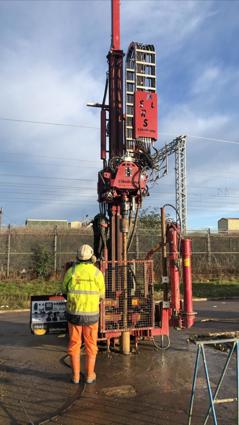Despite being a non-intrusive and important aspect of many different site investigations, ground penetration radar testing is often overlooked in the geotechnical world. For the most part, this is due to the fact that GPR gets the job done efficiently, quietly and without leaving a trace. It’s a method usually used to identify buried services prior to a careful evacuation, but can also be used to detect sinkholes and even features of karst geology. In fact, GPR isn’t limited to geotechnical settings at all. It can be used in archaeological and forensic settings too.
What is Ground Penetration Radar?
The word ‘radar’ is likely to conjure up thoughts of modern, or even futuristic, technology, which is why many may be surprised to discover that this technique is almost 100 years old. In fact, the first radar technology dates back to the late nineteenth century.
It was in 1926 that Dr Hülsenbeck patented his pulse radar system. Following this technical milestone, radar was utilised for the very first time in a geotechnical setting. Pulses of energy are sent into the sit under investigation - but how… and why?
How Does GPR Work?
High-frequency radio waves emitted by the ground penetration radar transmitter are sent directly into the ground. Upon hitting buried material - concrete, for example - the pulse is either reflected or scattered back up to the surface. The GPR receiver records the particular characteristics of the returned pulse which, in turn, allows for a comprehensive image of the subsurface to be developed.
The non-intrusiveness of the technique is, undeniably, its main advantage, as many of the features GPR is used to locate must be done so in the least intrusive way possible. Utilities will frequently be searched for with this technique, for example - such as gas works or fibre optic cables - beneath major arterial motorways. Any work that needs to be carried out in this type of setting will, of course, have a serious impact on the surrounding area due to road closures. Downtime is significantly mitigated, however, through the application of such a non-intrusive technique. On top of this benefit, GPR is considerably cheap in its operation too.

What Can GPR Identify?
To put it simply, GPR will detect pretty much any buried materials (or lack thereof). It can do this so accurately thanks to its method of recording the slightest changes in the subsurface environment. This means that it can be used to detect voids, as well as buried materials, including former coal workings and sinkholes.
How Accurate Is GPR?
Overall, ground penetration radar is an immensely accurate method of mapping and surveying. There are different factors that can result in varying accuracy, however, such as moisture content and material composition.
As GPR works on the basis that different subterranean features have different densities, and therefore send back the radar signal at different response speeds, anything that disrupts this process can be a potential problem. This means that dense near-surface material will reduce the depth the radar can penetrate. GPR can penetrate concrete, for example, but if the concrete is full of re-bar, the signal won’t penetrate as deeply.
Despite this, the century-old technique of ground penetration radar can largely be trusted to deliver reliable results.

John Rodgman is managing director at Borehole Solutions











Water Sector Talent Exodus Could Cripple The Sector
Maybe if things are essential for the running of a country and we want to pay a fair price we should be running these utilities on a not for profit...